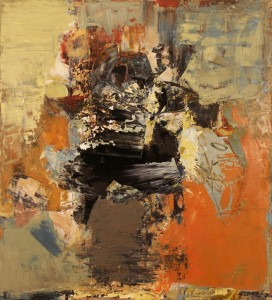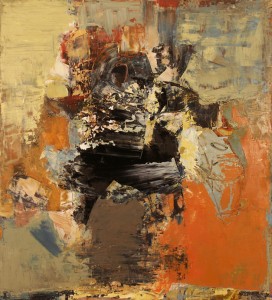
‘Summer Smoke and Paint’, Rebecca Gallery, Toronto
The Slipping Glimpser
Earl Miller, Independent Curator
September 2008
Ina Puchala’s richly layered abstract paintings bear the weight and the depth of an abstracted personal history that plays out on the canvas as a rich pastiche of colour and texture balancing action and stasis on a teetering edge.
This definitive notion of edge recalls how abstract expressionist painters such as Pollock and DeKooning attempted to visualize in abstraction the sensation of standing on the edge of an abyss. DeKooning, for instance, told of how he wished to stand on a cliff and glimpse far enough into the abyss that he almost fell. He had become, in his words, a “slipping glimpser.” Translated to canvas, DeKooning’s desire to almost fall meant his compositions were structured as freely as possible without dissipating into chaos. Likewise, Puchala pushes painting and by extension herself as far as possible within the context of painted communication.
Along with this overriding conceptual approach to painting, common formal qualities also connect Puchala’s work. Her paintings are – at least categorically – abstract. She exclusively uses a palette knife, at times applying paint in slathered slashes and at other times patting down flat fields of colour. The paint is pure and opaque; she does not dilute with thinner. An intense expressiveness defines her painting: thick, creamy swirls, spontaneous dashes, and electrically animated lines balance quieter pastoral spaces. She draws attention to just how varied this paint application is by exposing underpainting in the same way layers of paint and wallpaper are exposed by scraping away on a wall in an old house. She reveals an underlying history: the intense labour and thought processes leading to a completed painting. By doing so, Puchala proposes that the act of painting bears equal significance to the finished product.
While Puchala’s painting references the process-oriented action painting of the abstract expressionists, personal narrative rather than artistic lineage informs her work the most. The spectral presence of a lone abstracted figure in the compositional centres of many of her paintings is easily interpretable as a self-reference if not a self–portrait. Consider how in SS011 (2008) a black central shape bears just enough hints of a head, arms and legs that it appears to dance with limitless abandon – a whirling dervish in an on-the-edge state of freedom. Even works that focus on an overall rather than central composition such as SS006 (2008) contain an implied figure, in this case, an outline of black trails of paint in wildly pulsating motion.
Puchala tells me her writing journal provides her with much of the inspirational matter needed to paint. However, her narrative when painted is not strictly diaristic because it crosses into the realm of the imagination where the sometimes violent emotional underscorings of real life can surface without, as she says, “serious repercussions.” Accordingly she paints best after “a confrontational experience.”
Puchala demonstrates that abstract painting is about a kind of personal narrative that uses expressionism to look down into a sometimes darker, imaginative world. Ina Puchala’s painting may be of quotidian origins, but its outcome is ultimately about catharsis as a joyful liberation from the everyday.

‘Summer Smoke and Paint’, Rebecca Gallery, Toronto
The Slipping Glimpser
Earl Miller, Independent Curator
September 2008
Ina Puchala’s richly layered abstract paintings bear the weight and the depth of an abstracted personal history that plays out on the canvas as a rich pastiche of colour and texture balancing action and stasis on a teetering edge.
This definitive notion of edge recalls how abstract expressionist painters such as Pollock and DeKooning attempted to visualize in abstraction the sensation of standing on the edge of an abyss. DeKooning, for instance, told of how he wished to stand on a cliff and glimpse far enough into the abyss that he almost fell. He had become, in his words, a “slipping glimpser.” Translated to canvas, DeKooning’s desire to almost fall meant his compositions were structured as freely as possible without dissipating into chaos. Likewise, Puchala pushes painting and by extension herself as far as possible within the context of painted communication.
Along with this overriding conceptual approach to painting, common formal qualities also connect Puchala’s work. Her paintings are – at least categorically – abstract. She exclusively uses a palette knife, at times applying paint in slathered slashes and at other times patting down flat fields of colour. The paint is pure and opaque; she does not dilute with thinner. An intense expressiveness defines her painting: thick, creamy swirls, spontaneous dashes, and electrically animated lines balance quieter pastoral spaces. She draws attention to just how varied this paint application is by exposing underpainting in the same way layers of paint and wallpaper are exposed by scraping away on a wall in an old house. She reveals an underlying history: the intense labour and thought processes leading to a completed painting. By doing so, Puchala proposes that the act of painting bears equal significance to the finished product.
While Puchala’s painting references the process-oriented action painting of the abstract expressionists, personal narrative rather than artistic lineage informs her work the most. The spectral presence of a lone abstracted figure in the compositional centres of many of her paintings is easily interpretable as a self-reference if not a self–portrait. Consider how in SS011 (2008) a black central shape bears just enough hints of a head, arms and legs that it appears to dance with limitless abandon – a whirling dervish in an on-the-edge state of freedom. Even works that focus on an overall rather than central composition such as SS006 (2008) contain an implied figure, in this case, an outline of black trails of paint in wildly pulsating motion.
Puchala tells me her writing journal provides her with much of the inspirational matter needed to paint. However, her narrative when painted is not strictly diaristic because it crosses into the realm of the imagination where the sometimes violent emotional underscorings of real life can surface without, as she says, “serious repercussions.” Accordingly she paints best after “a confrontational experience.”
Puchala demonstrates that abstract painting is about a kind of personal narrative that uses expressionism to look down into a sometimes darker, imaginative world. Ina Puchala’s painting may be of quotidian origins, but its outcome is ultimately about catharsis as a joyful liberation from the everyday.